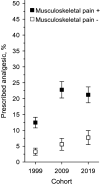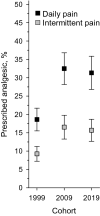Prevalence of Musculoskeletal Pain and Analgesic Treatment Among Community-Dwelling Older Adults: Changes from 1999 to 2019
- PMID: 34386937
- PMCID: PMC8484214
- DOI: 10.1007/s40266-021-00888-w
Prevalence of Musculoskeletal Pain and Analgesic Treatment Among Community-Dwelling Older Adults: Changes from 1999 to 2019
Abstract
Background: Pain is undertreated in older populations. At the same time, increased use of opioids is of concern in the Western world.
Aims: We sought to analyze temporal trends in musculoskeletal pain and prescribed analgesic treatment among community-dwelling people aged 75-95 years using cross-sectional cohort data spanning 20 years.
Methods: The Helsinki Aging Study recruited random samples of people aged 75, 80, 85, 90, and 95 years in 1999, 2009, and 2019. In total, 5707 community-dwelling persons participated in the study. The participants reported their medical diagnoses, regular prescription medications, and the presence of back pain or joint pain within the last 2 weeks (never, sometimes, or daily). We compared analgesic use among participants reporting and not reporting musculoskeletal pain in 1999, 2009, and 2019.
Results: Of the participants, 57-61% reported intermittent or daily musculoskeletal pain. The percentage receiving a prescribed daily analgesic increased from 9% in 1999 to 16% in 2019. The use of non-steroidal anti-inflammatory drugs (NSAIDs) decreased from 1999 to 2019, while the use of paracetamol increased from 2 to 11%. Opioids were taken by 2% in 1999 and 3% in 2019. Of those reporting daily musculoskeletal pain, 20%, 35%, and 32% received regular pain medication in 1999, 2009, and 2019, respectively.
Conclusions: Pain remains undertreated in the community-dwelling older population, although the use of regular prescribed analgesics increased between 1999 and 2019. The use of NSAIDs has decreased, while the use of paracetamol has increased. Daily opioid use has remained modest.
© 2021. The Author(s).
Conflict of interest statement
Dr Strandberg reports educational cooperation with Servier, Orion, and Novartis, and is a member of the European Geriatric Medicine Society (EuGMS) special interest group on cardiovascular medicine in older people and diabetes in older people. Dr Pitkälä, Dr Öhman, Dr Karppinen, Dr Tilvis, Lehti, Knuutila, Rinkinen, Dr Roitto, Dr Aalto, and Kautiainen declare no conflicts of interest.
Figures


Similar articles
-
Musculoskeletal pain and its treatment among older home-dwelling people: ten-year changes in two Finnish birth cohorts.Arch Gerontol Geriatr. 2013 Jan-Feb;56(1):285-9. doi: 10.1016/j.archger.2012.08.014. Epub 2012 Sep 28. Arch Gerontol Geriatr. 2013. PMID: 23022058
-
Pain medication management of musculoskeletal conditions at first presentation in primary care: analysis of routinely collected medical record data.BMC Musculoskelet Disord. 2014 Dec 10;15:418. doi: 10.1186/1471-2474-15-418. BMC Musculoskelet Disord. 2014. PMID: 25492581 Free PMC article.
-
Management of nonmalignant pain in home-dwelling older people: a population-based survey.J Am Geriatr Soc. 2002 Nov;50(11):1861-5. doi: 10.1046/j.1532-5415.2002.50517.x. J Am Geriatr Soc. 2002. PMID: 12410908
-
Guidance on the management of pain in older people.Age Ageing. 2013 Mar;42 Suppl 1:i1-57. doi: 10.1093/ageing/afs200. Age Ageing. 2013. PMID: 23420266 Review.
-
Efficacy and Safety of Oral and Transdermal Opioid Analgesics for Musculoskeletal Pain in Older Adults: A Systematic Review of Randomized, Placebo-Controlled Trials.J Pain. 2018 May;19(5):475.e1-475.e24. doi: 10.1016/j.jpain.2017.12.001. Epub 2017 Dec 11. J Pain. 2018. PMID: 29241834
Cited by
-
World guidelines for falls prevention and management for older adults: a global initiative.Age Ageing. 2022 Sep 2;51(9):afac205. doi: 10.1093/ageing/afac205. Age Ageing. 2022. PMID: 36178003 Free PMC article.
-
Pharmacological Pain Treatment in Older Persons.Drugs Aging. 2024 Dec;41(12):959-976. doi: 10.1007/s40266-024-01151-8. Epub 2024 Oct 27. Drugs Aging. 2024. PMID: 39465454 Free PMC article. Review.
-
Self-Reported Pain Treatment Practices Among U.S. and Canadian Adults: Findings From a Population Survey.Innov Aging. 2023 Sep 16;7(10):igad103. doi: 10.1093/geroni/igad103. eCollection 2023. Innov Aging. 2023. PMID: 38094928 Free PMC article.
-
Joint Pain and Leisure-Time Physical Activity: Cross-Sectional Findings From the Cardiovascular Health Study.Health Sci Rep. 2025 Feb 12;8(2):e70367. doi: 10.1002/hsr2.70367. eCollection 2025 Feb. Health Sci Rep. 2025. PMID: 39949522 Free PMC article.
-
Clinical Pharmaceutical Care in Nursing Home Residents as a Cornerstone for Drug-Related Problems Identification.Clin Transl Sci. 2025 May;18(5):e70222. doi: 10.1111/cts.70222. Clin Transl Sci. 2025. PMID: 40388195 Free PMC article.
References
-
- Brochet B, Michel P, Barberger-Gateau P, Dartigues J-F. Population-based study of pain in elderly people: a descriptive survey. Age Ageing. 1998 doi: 10.1093/ageing/27.3.279. - DOI
Publication types
MeSH terms
Substances
LinkOut - more resources
Full Text Sources

